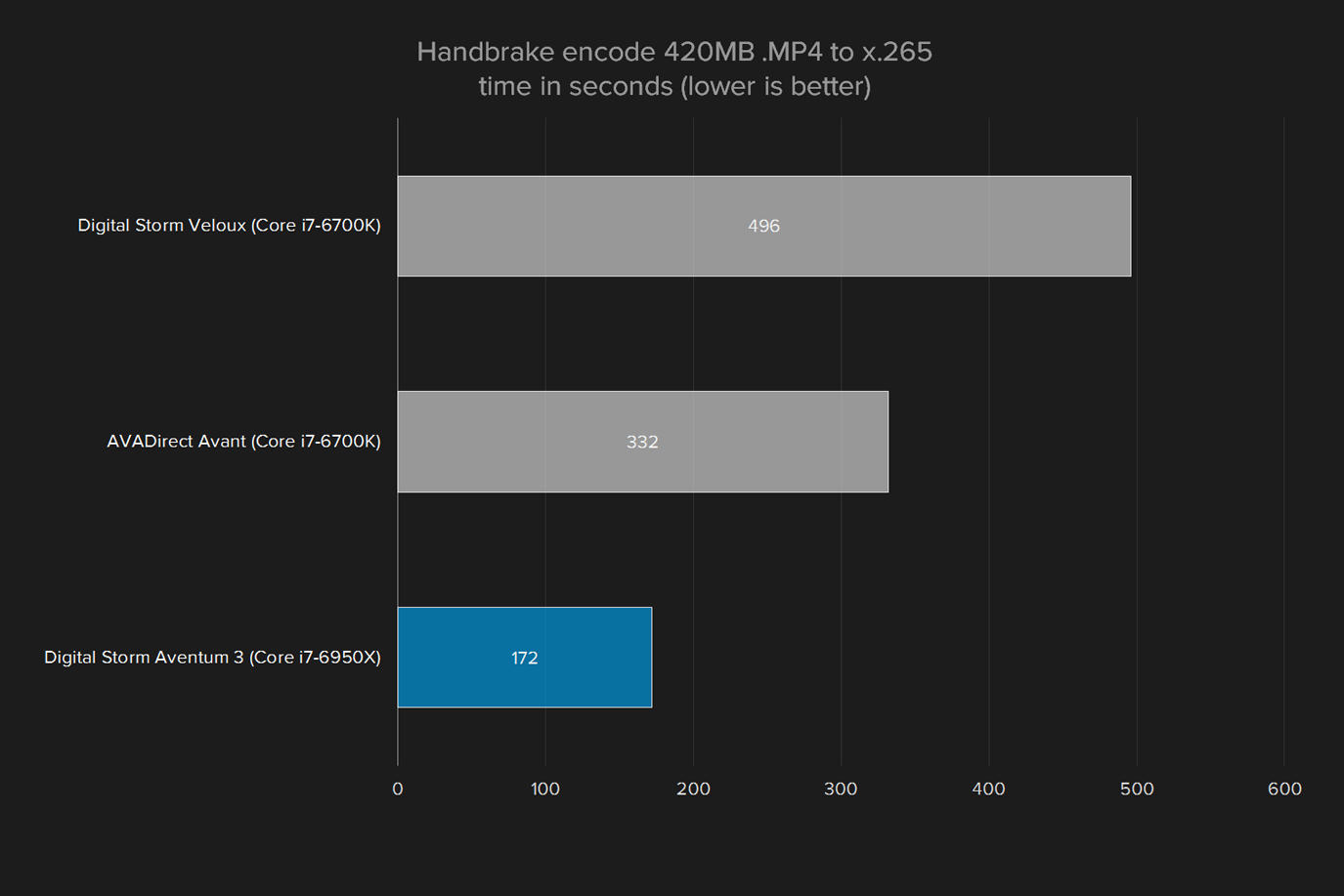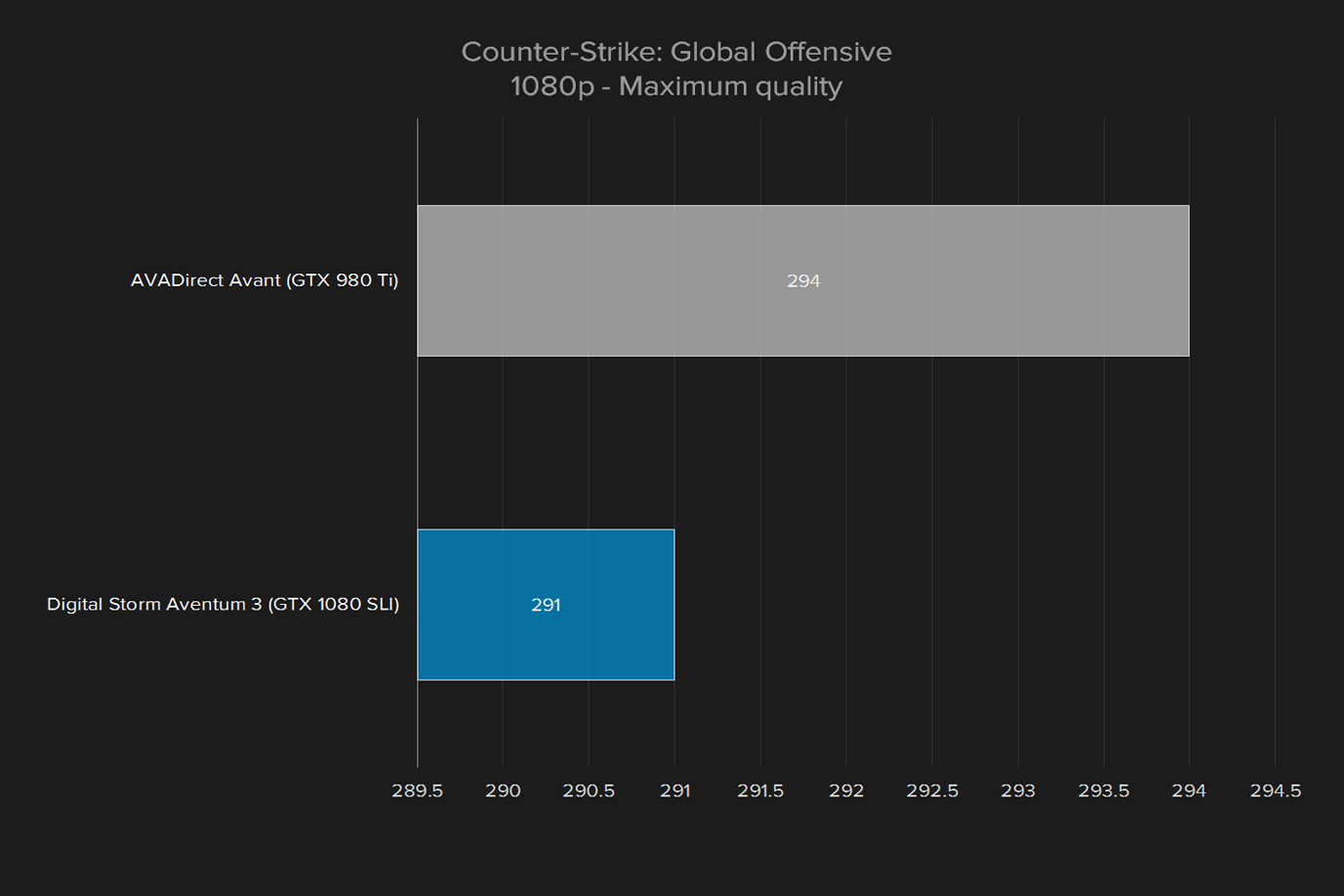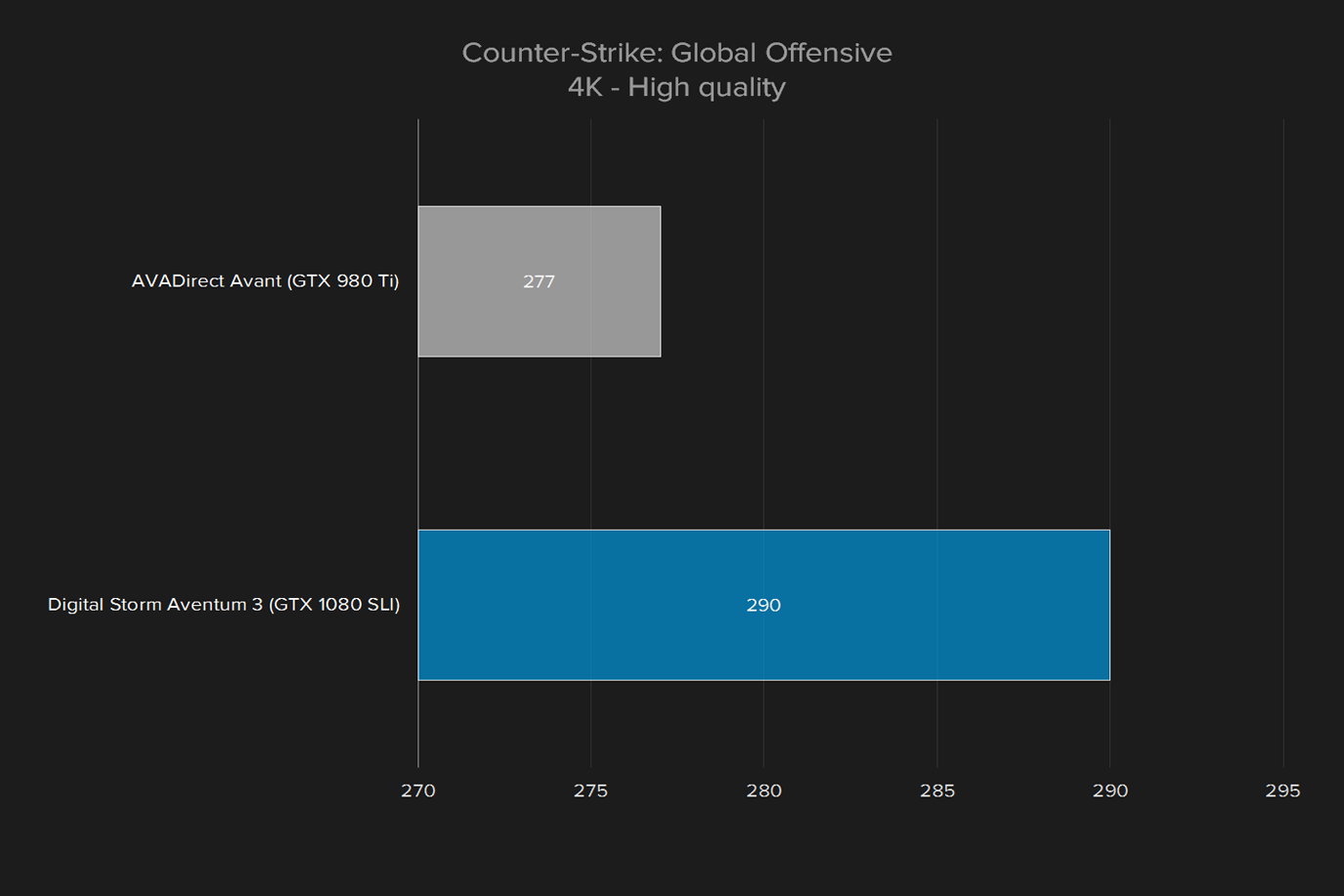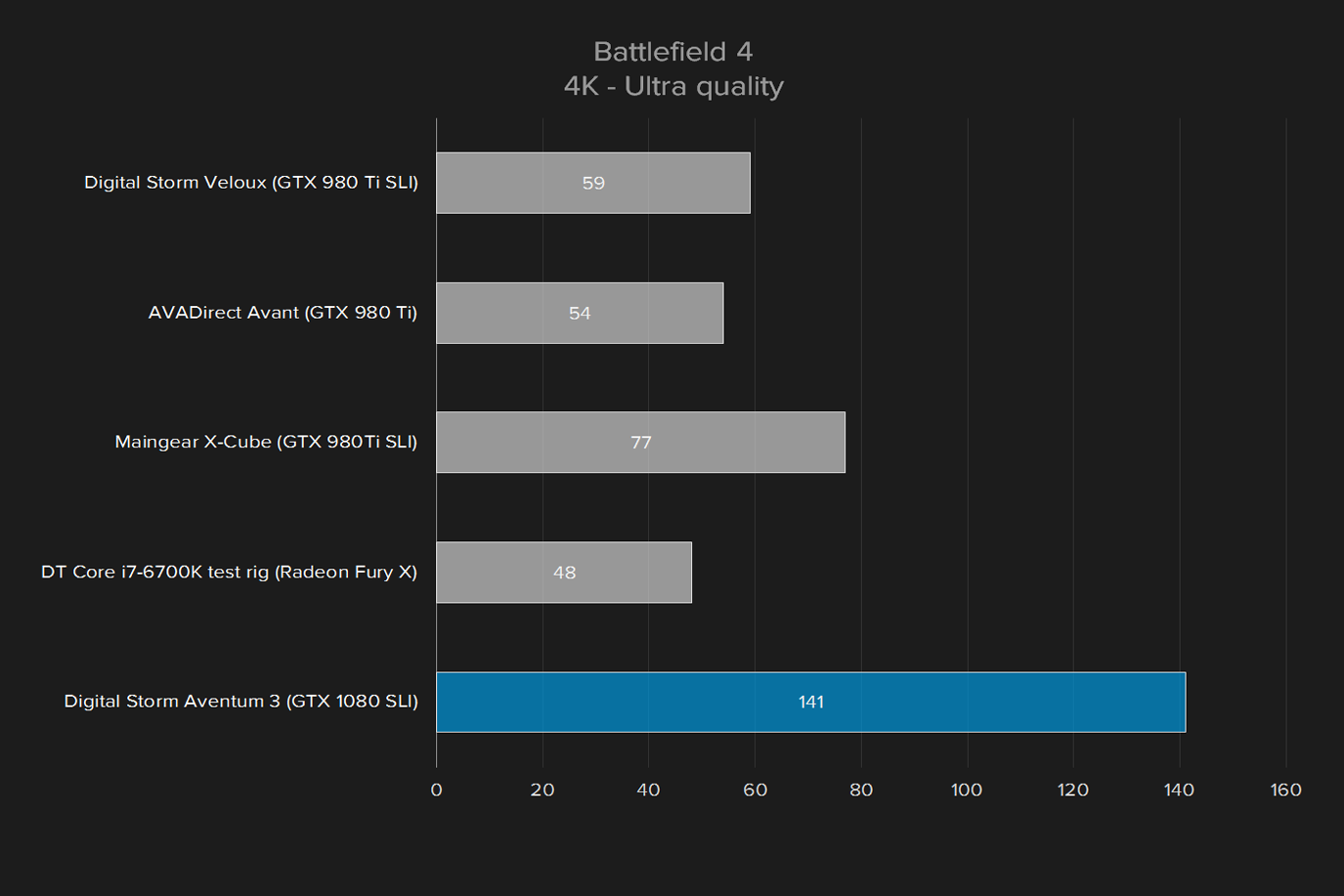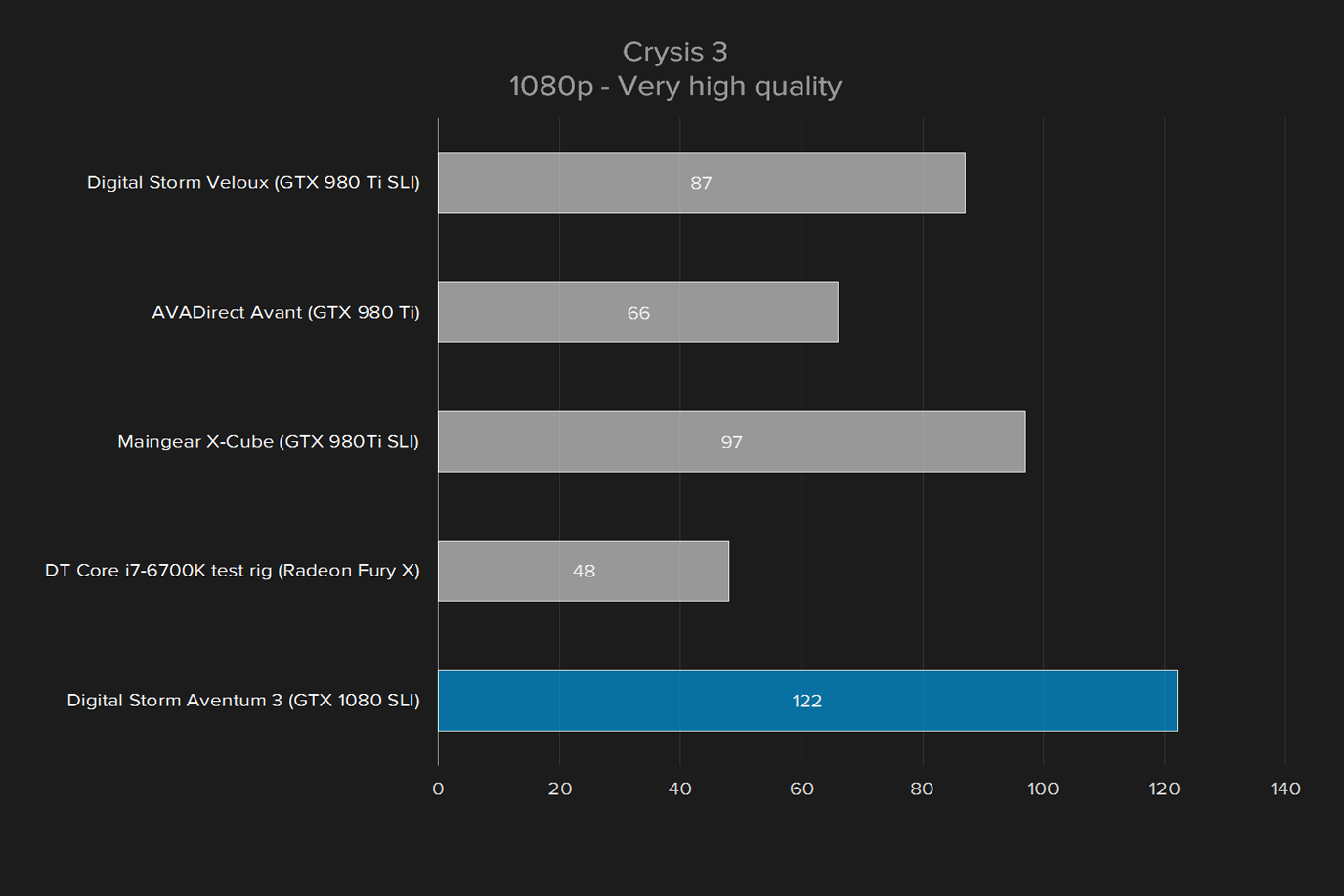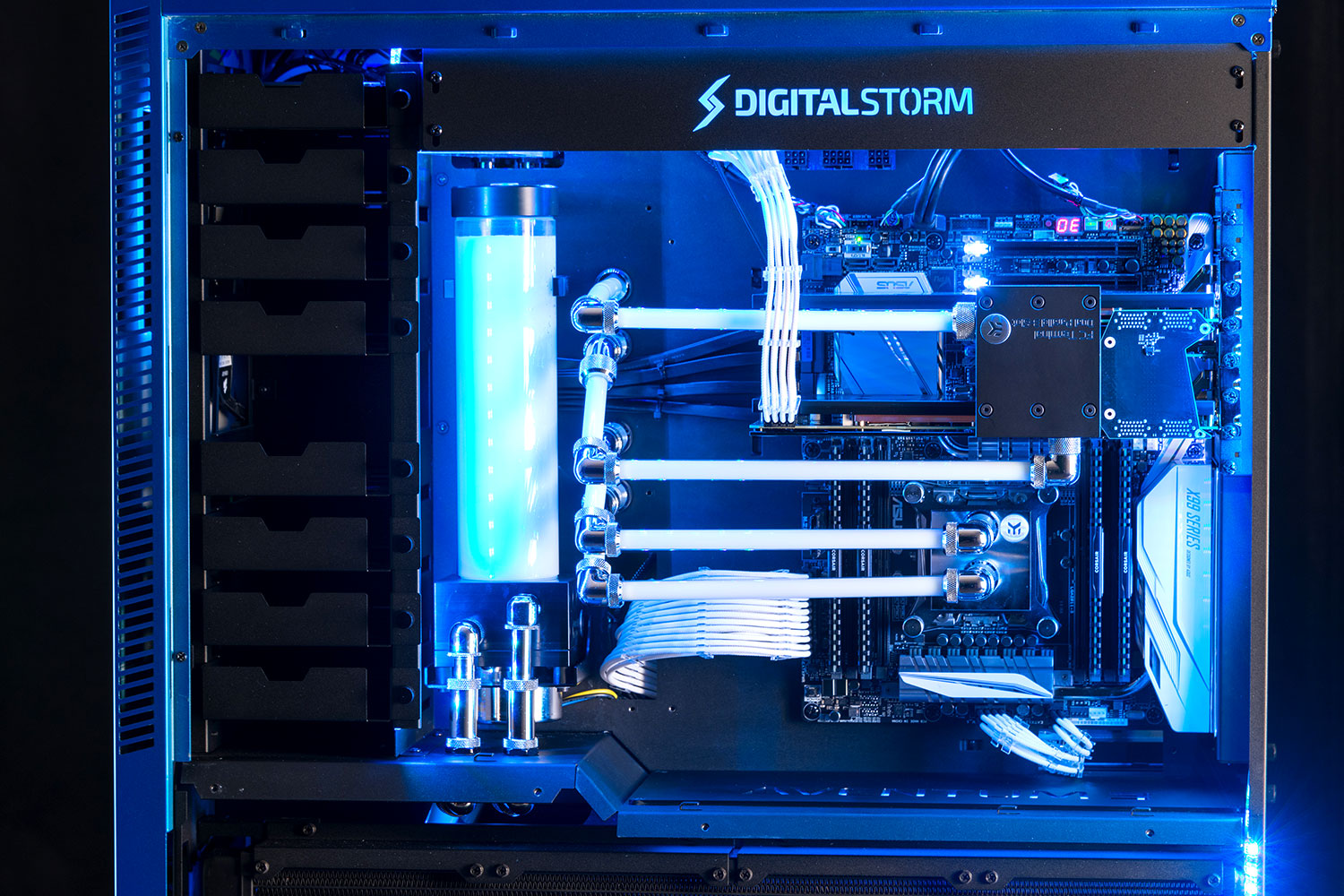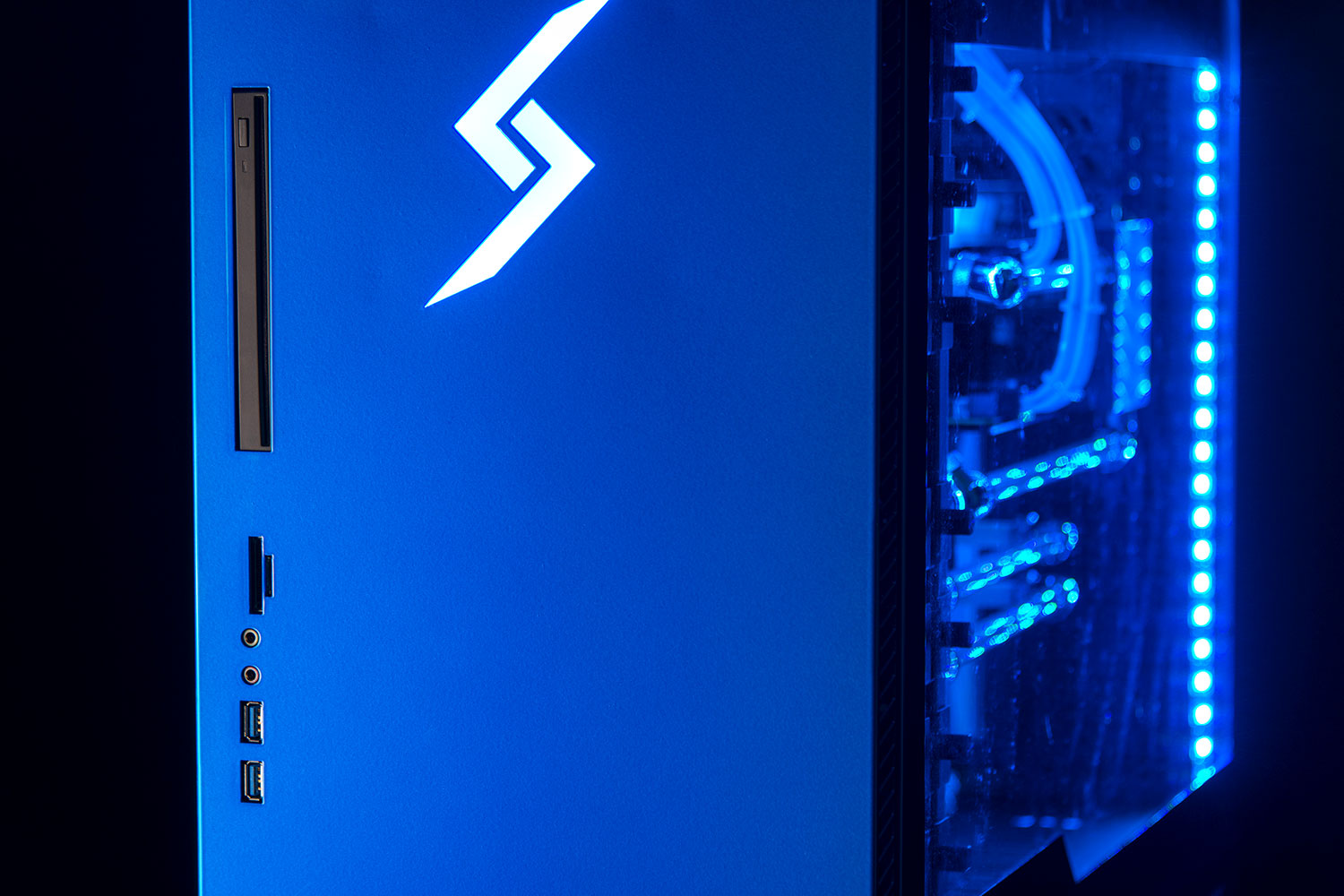“The Aventum 3 is an ostentatious showpiece of modern PC hardware.”
- Massive, handsome enclosure
- Easy to open, repair, upgrade
- Incredible performance in all areas
- Relatively quiet
- Weight makes system hard to move
- More expensive than similar competitors
Every major electronics or gaming show is littered with extreme, massive computers, crammed with insanely powerful hardware and high-end liquid cooling. They’re incredible in their impracticality, built for seemingly no reason other than “because we can.” Almost none of them actually translate to rigs you can buy — but Digital Storm’s Aventum 3 is an exception.
To call this system a flagship would be an understatement. It’s an entire flotilla all wrapped into one, the PC equivalent of the Death Star. Starting at $3,900, the Aventum 3’s pricing quickly launches itself into “omg, really?” territory. Our review unit’s MSRP, at time of this writing, is about $8,600.
You could buy a used car for that. Still, as you’d hope, this desktop has the most powerful hardware a consumer can purchase. Its Core i7-6950X processor boasts 10 cores, and in our review system was overclocked to 4.3GHz. It also came with 32GB of memory, 512GB of solid state storage, and not one but two GTX 1080 video cards, both overclocked. To keep the hardware stable, Digital Storm shipped our Aventum 3 with its custom “HydroLux” liquid cooling.
Living large
We’ve tested a lot of plus-sized desktops at Digital Trends, such as Origin’s Millennium and Falcon Northwest’s Mach V. But the Digital Storm Aventum 3 is a titan among giants. It shocked us with its shipping weight of 160 pounds. Most people will not be able to move this system far without help. It’s so heavy, in fact, that we wish it had some built-in way of mitigating that fact, like low-friction feet or retractable wheels.
Some of the weight is due to the incredible hardware inside this rig, but the enclosure itself deserves plenty of blame. It absolutely dwarfs even full-tower desktops. We measured it at about 28 inches tall, two feet long, and almost a foot wide. This alone is enough to make the PC a conversation starter.
And that’s before talking about the paint. The Aventum 3 comes with a black metallic matte finish by default, but a variety of metallic gloss finishes are available, or you can even choose your own. The standard paint options are $500, and the custom option is $800.
Size aside, this desktop takes a simple, elegant approach. Its metal panels are straight and true, and punctuated by two large case windows, one on each flank. Customizable LED lighting shines inside, and the Digital Storm logo glows up front. Every box on the custom PC checklist is filled, without deviation.
Still, the sheer size and audacity of the Aventum 3 ensures no one will call it boring. And, on close inspection, the details begin to stand out. This is an expertly produced desktop. Every wire is carefully arranged, every liquid-cooling pipe precisely connected. Like most precision-engineered machines, this rig is beautiful not because of its aesthetic traits, but because it’s the tangible result of serious skill.
Inside the belly of the beast
The Aventum 3’s size is both an advantage and a disadvantage when it comes time to replace or upgrade a component. There’s plenty of room to work with, so there’s no concern about whether a new part will fit, or if there’ll be enough space for proper cooling. But the weight of the system means that it’s hard to move to a proper working location.
Wherever you work on it, Digital Storm makes access easy. There’s a total of four case panels, one upper and one lower on each side. The upper half contains the majority of hardware including the motherboard, processor, memory, video cards, and storage. Down below the power supply, radiators, and cooling fans lurk. All of the case panels are secured with easily handled thumbscrews that are permanently attached to the case panels, so you can’t lose them.
4K gaming is the true test of this rig’s power, and it passes without hesitation.
Digital Storm has cleverly made sure that no case wires or fans connect to the large upper panels, so they can be removed freely. Power cables for case fans do connect the lower panels, but they’re arranged so that the cable is long enough to allow the panel to be laid on the floor. The hard drive bays (which number eight in total) are easy to work with, too, as all are secured with a single thumbscrew, and all can be fully removed.
It’s clear a lot of thought was put into how users might upgrade the Aventum 3. It’s a shame, then, that our review unit’s liquid cooling system negates much of it. Coolant pipes block some RAM slots and the M.2. drive, making their replacement tricky. Replacing the processor or video cards will mean pumping coolant out of the system before you take them out. And the massive radiators in the bottom half block easy access to the power supply.
These problems aren’t unique to the Aventum 3. All liquid cooled systems must deal with these issues. Choosing to stick with air cooling would make all these issues disappear, and also significantly reduce the system’s weight, leaving you with a big, spacious, easily upgraded PC. Going dry even shaves over $1,000 from the price.
Meet the fastest consumer CPU, ever
Intel’s Core i7-6950X powers the Aventum 3. We’ve already reviewed the processor, and found it the quickest stock processor we’ve ever tested, at least in multi-core testing. However, the processor didn’t win every benchmark. In some cases, it lost Core i7-5960X processors overclocked by boutique manufacturers.
Fortunately, Digital Storm has overclocked the Core i7-6950X to 4.3GHz. That’s an increase of 1.3GHz, or about 43 percent, compared to the stock chip. Predictably, the chip shattered all our CPU benchmark records.
The Geekbench multi-core score tells the whole story. The Aventum 3 hits 40,438, which is 25 percent higher than the score of 30,069 we saw from Falcon Northwest’s Tiki, which had a Core i7-5960X overclocked to 4.3GHz. The Core i7-6700K systems shown in the graph, which were overclocked to around 4.7GHz, are way behind. Handbrake is the most impressive show of the Core i7-6950X’s power, as it encoded our 420 megabyte, 4K test trailer to x.265 in only 172 seconds. That’s by far the quickest time we’ve seen yet.
There is one test where the Aventum 3 loses, and that’s Geekbench single-core. Remember, the Core i7-6950X in the Aventum 3 was overclocked to “only” 4.3GHz, which is lower than an overclocked Intel Core i7-6700K, which typically hits 4.7 to 4.8GHz. Put simply, any single core in the Core i7-6700K is quicker than any single core in the Core i7-6950X. Fortunately for the ten-core monster, there are exceedingly few scenarios where that disadvantage matters. Any application designed with performance in mind is going to use multiple threads.
A world-class hard drive, too
While hard drive performance isn’t the star of this show, the Digital Storm didn’t wimp out. The Aventum 3 was sent to us packing a Samsung 950 Pro hard drive attached to the motherboard’s M.2 slot. Known as one of the quickest consumer SSDs available, the 950 Pro quickly tore through our benchmarks.
With sequential read speeds hitting almost two gigabytes per second, and sustained reads hitting almost one gigabyte per second, it’s clear this system’s solid state drive will never be a bottleneck.
Gamers are gonna love this
Clearly, the Aventum 3 is powerful enough to qualify as a workstation desktop. It can make quick work of anything a professional video editor or programmer might throw at it. But Digital Storm primarily markets the Aventum 3 as a gaming desktop. Our review unit came with a pair of GTX 1080 video cards, each overclocked to a maximum Boost Clock setting of just over 2GHz, up about 15 percent over the stock Boost maximum of 1,733MHz. The result is pure overkill.
The Aventum 3’s Fire Strike score of 28,829 is by far the highest we’ve ever witnessed, beating the previous record holder, an AVADirect X99 gaming system with two GTX 980 Ti cards, by over 8,000 points. Importantly, we’ve never had much luck getting Fire Strike to consistently recognize multiple cards, so this result is really measuring the margin of victory for a single GTX 1080 with a powerful overclock. It’s an impressive score, to say the least.
Gaming at 1080p is easy for the Aventum 3. So easy, in fact, that its scores are held back by game engine or driver limitations more often than the hardware. You’ll notice, for example, that it scores about the same as less powerful competitors in Counter Strike: GO and Battlefield 4. Both game engines have a framerate hard cap (300 and 200FPS, respectively.) The Aventum 3 also posts a modest score in Heroes of the Storm. This game does not appear to have a hard cap, but we’ve seen diminishing returns on high-end hardware. So far as we’ve determined, it appears that single-thread clock speed is the limiting factor in that game. Not that it matters – 231 frames per second is plenty.
4K gaming is the true test of this rig’s power. And it passes that test without hesitation, settings records across the board. The most notable wins come in Fallout 4 and Battlefield 4. The Aventum 3 is the first PC we’ve reviewed to exceed 80 FPS in either game at 4K and maximum detail. Aside from the Maingear X-Cube, it’s the first desktop we’ve tested to exceed even 60 FPS at those settings.
There’s only one game that can challenge this mighty system. Crysis 3. At 4K resolution, with all the details turned up to maximum, the framerate averaged 40 FPS. That’s quite far below the ideal 60 FPS, but it’s playable, and eight FPS better than any other desktop we’ve ever reviewed.
Surprisingly quiet
Though liquid cooled, our Aventum 3 reviewed unit had plenty of case fans. We counted a total of nine. That’s way more than most consumer PCs, and it might lead gamers to worry about noise.
In fact, the system is rather quiet. It produced no more than 40.8 decibels at idle, and hit a maximum of 48 decibels at full system load. That’s slightly louder than the majority of Core i7 systems we’ve tested. Origin’s Millennium, for example, was a whisper-quiet 39.6 decibels in even the most demanding workloads. But the Aventum 3 is quieter than the Maingear X-Cube or Origin Chronos.
We also thought the rig seemed quieter than the numbers said. The fans had a lazy, sighing quality to them, absent any harsh rattles or high-pitched whine. While the liquid coolant pump made some noise, its workings calmed within a few minutes of hitting the power button. Most people should find little reason to complain about the overall level and quality of noise.
Confusing warranty terms
Digital Storm ships most of its desktops, including this one, with a three-year limited warranty. It’s not as good as it sounds. By default, the warranty only covers labor, not parts, which are covered for just one year. To make matters worse, many competitors have a free lifetime labor warranty. A few, like Falcon Northwest’s Mach V, come with a standard three-year warranty on parts and labor.
Of course, you can upgrade to a better warranty. A three year parts warranty is $300, and comes with five years of coverage on labor.
Conclusion
The Aventum 3 is an exercise in excess, larger than any of its competitors, and available with high-end options that aren’t offered by most companies. It’s handsome, hugely upgradable, and devastatingly quick, felling all of our performance benchmarks with ease. As you’d expect it to, given its MSRP of around $8,600.
As we noted earlier, though, the high price is a bit misleading. The custom paint job alone adds $500, and the expensive liquid cooling system causes as many problems as it solves. If those options are removed, the system’s price can be dropped to a still extreme, but more reasonable, $6,500.
That’s less, but also still a lot. A similarly equipped Origin Millennium rings up to about $6,050, while a similar Falcon Northwest Mach V can be had for $6,150. Both systems can offer roughly equivalent performance, as they offer the same overclocking service as Digital Storm, and the same high-end video cards. When all the figures are tallied, it appears the Aventum 3 is about $400 more expensive than its prime rivals.
Where’s that extra cash going? The enclosure. While the systems from Falcon and Origin are attractive, they have drawbacks compared to the Aventum 3. Falcon’s Mach V doesn’t offer case windows, so it lacks the look-at-me presence of the Digital Storm. Origin’s alternative is attractive and customizable, but also has many plastic panels, which don’t look or feel as premium as the Aventum 3.
Do these disadvantages justify the price gap? The answer depends on whether you’re looking for a computer with world beating performance, or a showpiece. Competitors from Falcon Northwest and Origin can do all the Aventum 3 can, for less, and in enclosures that are ultimately more practical. But they’re nowhere as ostentatious. Digital Storm’s flagship is for geeks who want to brag.








